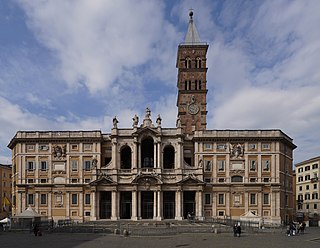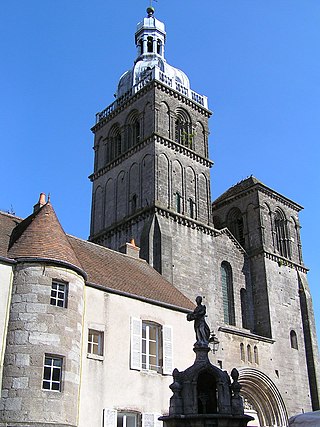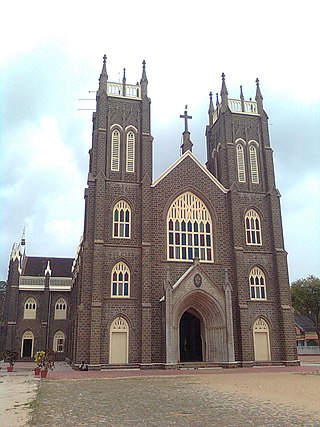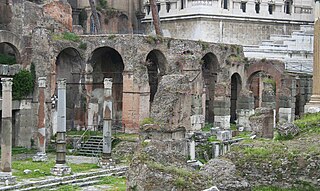
In Ancient Roman architecture, a basilica was a large public building with multiple functions that was typically built alongside the town's forum. The basilica was in the Latin West equivalent to a stoa in the Greek East. The building gave its name to the architectural form of the basilica.
Pope Mark was the bishop of Rome from 18 January to his death on 7 October 336.

The Papal Basilica of Saint Peter in the Vatican, or simply Saint Peter's Basilica, is an Italian Renaissance and Baroque church located in Vatican City, an independent microstate enclaved within the city of Rome, Italy. It was initially planned in the 15th century by Pope Nicholas V and then Pope Julius II to replace the aging Old St. Peter's Basilica, which was built in the fourth century by Roman emperor Constantine the Great. Construction of the present basilica began on 18 April 1506 and was completed on 18 November 1626.

The Papal Basilica of Saint Paul Outside the Walls is one of Rome's four major papal basilicas, along with the basilicas of Saint John in the Lateran, Saint Peter's, and Saint Mary Major, as well as one of the Seven Pilgrim Churches of Rome.

In architecture, an apse is a semicircular recess covered with a hemispherical vault or semi-dome, also known as an exedra. In Byzantine, Romanesque, and Gothic Christian church architecture, the term is applied to a semi-circular or polygonal termination of the main building at the liturgical east end, regardless of the shape of the roof, which may be flat, sloping, domed, or hemispherical. Smaller apses are found elsewhere, especially in shrines.

The Basilica of Saint Mary Major, or church of Santa Maria Maggiore, is a Major papal basilica as well as one of the Seven Pilgrim Churches of Rome and the largest Catholic Marian church in Rome, Italy.

Our Lady of Sorrows Basilica is a Catholic basilica on the West Side of Chicago, Illinois, which also houses the National Shrine of Saint Peregrine. Located at 3121 West Jackson Boulevard, within the Archdiocese of Chicago, it is, along with St. Hyacinth and Queen of All Saints, one of only three churches in Illinois designated by the Pope with the title of basilica.

Saint Peter's Square is a large plaza located directly in front of St. Peter's Basilica in Vatican City, the papal enclave in Rome, directly west of the neighborhood (rione) of Borgo. Both the square and the basilica are named after Saint Peter, an apostle of Jesus whom Catholics consider to be the first Pope.

The Basilica Papale di San Lorenzo fuori le mura is a Roman Catholic papal minor basilica and parish church, located in Rome, Italy. The Basilica is one of the Seven Pilgrim Churches of Rome and one of the five "papal basilicas", each of which was assigned to the care of a Latin Church patriarchate. The basilica was assigned to the Patriarchate of Jerusalem. The basilica is the shrine of the tomb of its namesake, Lawrence, one of the first seven deacons of Rome who was martyred in 258. Many other saints and Pope Pius IX are also buried at the Basilica, which is the centre of a large and ancient burial complex.

The Basilica Cistern, or Cisterna Basilica, is the largest of several hundred ancient cisterns that lie beneath the city of Istanbul, Turkey. The cistern, located 150 metres (490 ft) southwest of the Hagia Sophia on the historical peninsula of Sarayburnu, was built in the 6th century during the reign of Byzantine emperor Justinian I. Today it is kept with little water, for public access inside the space.

The Basilica of Santa María de Guadalupe, officially called Insigne y Nacional Basílica de Santa María de Guadalupe is a basilica of the Catholic Church, dedicated to the Virgin Mary in her invocation of Our Lady of Guadalupe, located at the foot of the Hill of Tepeyac in the Gustavo A. Madero borough of Mexico City. It belongs to the Primate Archdiocese of Mexico through the Guadalupana Vicariate, which since November 4, 2018, is in the care of Monsignor Efraín Hernández Díaz, who has the title of general and episcopal vicar of Guadalupe and abbot of the basilica.

Saulieu is a rural commune in the Côte-d'Or department in the Bourgogne-Franche-Comté region in eastern France. Its 2,413 inhabitants call themselves Sédélociens.

Old St. Peter's Basilica was the building that stood, from the 4th to 16th centuries, where St. Peter's Basilica stands today in Vatican City. Construction of the basilica, built over the historical site of the Circus of Nero, began during the reign of Emperor Constantine I. The name "old St. Peter's Basilica" has been used since the construction of the current basilica to distinguish the two buildings.

The National Shrine Basilica of Our Lady of Ransom aka Vallarpadam Basilica located in Vallarpadam, a suburb in Ernakulam, in the city of Kochi, is a minor basilica and a major Christian pilgrimage centre in India. Around 5 million people visit the basilica every year. People from all parts of the world irrespective of caste or creed go to the church to seek the blessings of the Blessed Virgin Mary, mother of Jesus, popularly known as "Vallarpadathamma".

Lalouvesc is a commune in the Ardèche department in the southern east region of France.

The largest shrine of St Sebastian in the world, the church known as Arthunkal St. Andrew's Basilica and St. Sebastian's International Shrine in Arthunkal, Cherthala, Alappuzha district, Kerala, India, was constructed by Portuguese missionaries in the 16th century. The grand annual feast of St Sebastian Arthunkal in January, which lasts for a month accompanied by millions of pilgrims is one of the important celebrations and major attractions in India.The feast of shrine Basilica also known as makaram perunnal. The church was rebuilt in 1584 under the vicar Jacomo Fenicio, an Italian Jesuit whose devotees claim to possess powers to heal the body and mind. Devotees fondly referred to him as "Arthunkal Veluthachan", "fair skinned father". Fenicio died in 1632. Eight years after his death, the church was rebuilt again, this time reoriented to face west towards the long white-sand beach on the shores of the Arabian Sea. In 1647, a statue of St. Sebastian, struck with arrows all over his bleeding body sculptured in Milan, was brought and placed in the Arthunkal church.

The Basilica Argentaria is a portico with pillars lining the Temple of Venus Genetrix in the Forum of Caesar in Rome (Italy). The name only appears in late sources of the age of Constantine.

The Porta Maggiore Basilica is an underground basilica discovered in 1917 near Porta Maggiore in Rome. It is dated to the first century BC. It is believed to have been the meeting place of the neo-Pythagoreans, and is the only historical site that has been associated with the neo-Pythagorean movement. This school of mystical Hellenistic philosophy preached asceticism and was based on the works of Pythagoras and Plato. It was a precursor to the basilicas built during the Christian period, centuries later. It was opened to small groups of visitors in April 2015.

Basilicas are Catholic church buildings that have a designation, conferring special privileges, given by the Pope. Basilicas are distinguished for ceremonial purposes from other churches. The building need not be a basilica in the architectural sense. Basilicas are either major basilicas, of which there are four, all in the Diocese of Rome, or minor basilicas, of which there were 1,810 worldwide as of 2019.



















